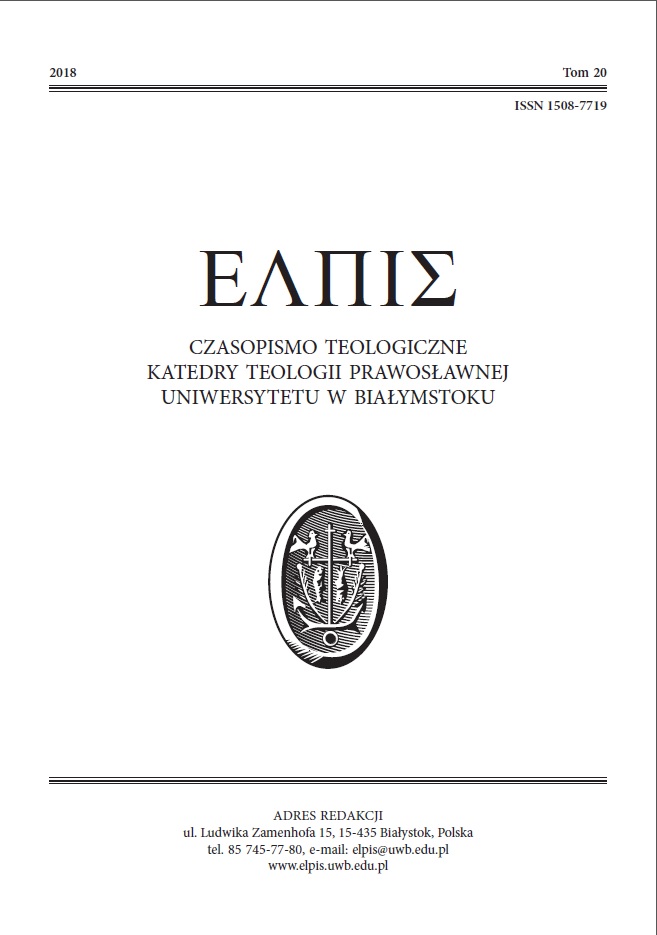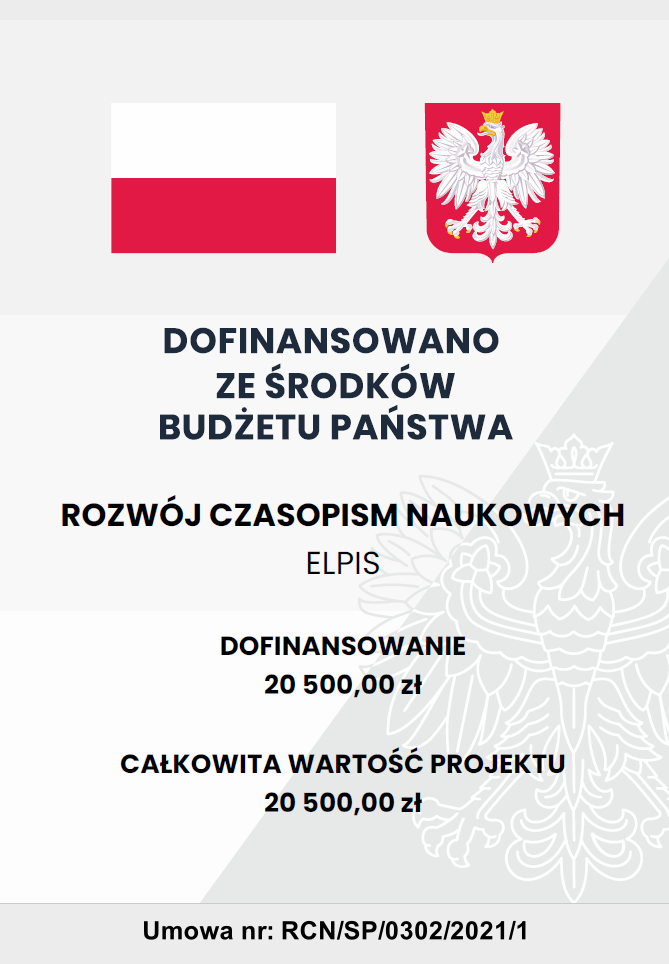The non-ethereal connection between christian spirituality and human health
DOI:
https://doi.org/10.15290/elpis.2018.20.12Keywords:
religion, prayer, meditation, immunology, healthAbstract
Health is defined as a state of complete physical, mental and social well-being of a human being, not just a complete absence of disease or disability. Over the years, the basic definition proposed by the WHO has been extended to include another component: the ability to lead an effective social and economic life, as well as the spiritual dimension. The spiritual health of man since the beginning of human consciousness is inseparably connected with the relationship with God. In achieving full health, it is extremely important to achieve a harmonious interaction and coexistence of the spiritual sphere with the physical one. Religious practices are common attempts to create a bridge between the perceivable and measurable state of matter, and the experimental extrasensory spiritual world. Religious practices have been repeatedly associated with the treatment of different diseases and causing the improvement of physiological
parameters may contribute to the actual improvement of human health. Prayer can affect the functioning of the body through various mechanisms. It was found that transcendental meditation with mystical dominance gives significant pro-health effects. Many publications prove that prayer and religious practices have a significant influence in regulating of autonomic, hormonal and mental systems. Practitioners less often suffer from diseases caused by excessive high stress level. Evidence for a positive correlation between practicing religious practices and measurable parameters, such as level of IL-6, lengths of telomeres, level of CD4 + T cell and mental health, was found. It seems likely that people devoting themselves to religious practices may be characterized by a lower incidence of certain somatic diseases. The results of the research suggest the need to re-open to other, not only “somatic” forms of therapy, which in a skilful and
individualized way should complement the basic methods of therapy currently used. Health care workers, in addition to paying more attention to the spiritual background of existing somatic disorders, should work more closely with psychologists, psychiatrists and clergymen to coordinate a holistic approach to patient care, which should also include aspects of the individual’s spirituality.
Downloads
References
Al-Ayadhi, L.Y. (2005). Neurohormonal changes in medical students during academic stress. Ann Saudi Med., 25(1), 36-40.
Ałfiejew, H. (2009). Misterium wiary. Wprowadzenie do Prawosławnej teologii dogmatycznej. Warszawa: Warszawska Metropolia Prawosławna, 223.
Anderson, J.W., Liu, C., Kryscio, R.J. (2008). Blood pressure response to transcendental meditation: a meta-analysis. Am J Hypertens, 21(3), 310-366. doi: 10.1038/ajh.2007.65.
Andrade, C., Radhakrishnan, R. (2009). Prayer and healing: A medical and scientific perspective on randomized controlled trials. Indian J Psychiatry, 51, 247-253.
Barnes, V.A., Davis, H.C., Murzynowski, J.B., Treiber, F.A. (2004). Impact of meditation on resting and ambulatory blood pressure and heart rate in youth. Psychosom Med., 66(6), 909-914.
Breen, M.S., Beliakova-Bethell, N., Mujica-Parodi, L.R., Carlson, J.M., Ensign, W.Y., Woelk, C.H., Rana, B.K. (2016).
Acute psychological stress induces short-term variable immune response. Brain Behav Immun., 53, 172-182. doi:10.1016/j.bbi.2015.10.008.
Cahill, S.P., Pontoski, K. (2005). Post-Traumatic Stress Disorder and Acute Stress Disorder I: Their Nature and Assessment Considerations. Psychiatry (Edgmont), 2(4), 14–25.
Carr, J., Whipple, T. (6 grudnia 2006). A foolproof anti cancer diet... with just one or two drawbacks. The Times [on-line].
Chuengsatiansup, K. (2003). Spirituality and health: an initial proposal to incorporate spiritual health in health impact assessment. Environmental Impact Assessment Review, 23, 3-15.
Collingwood, J. (2016). How Does Mood Affect Immunity?. Psych Central. Retrieved on March 15, 2017.
D’Acquisto, F. (2017). Affective immunology: where emotions and the immune response converge. Dialogues in Clinical Neuroscience, 19(1), 9–19.
Dalmida, S.G., Holstad, M.M., DiIorio, C., Laderman, G. (2009). Spiritual well-being, depressive symptoms, and immune status among women living with HIV/AIDS. Women Health., 49(2-3), 119-43. doi: 10.1080/03630240902915036.
Davidson, R.J., Kabat-Zinn, J., Schumacher, J., Rosenkranz, M., Muller, D., Santorelli, S.F., Urbanowski, F., Harrington, A., Bonus, K., Sheridan, J.F. (2003). Alterations in brain and immune function produced by mindfulness meditation. Psychosom
Med., 65(4), 564-570.
Evdokimov, P. (1986). Prawosławie. Warszawa: Instytut Wydawniczy PAX.
Heszen-Niejodek, I., Gruszczyńska, E. (2004). Wymiar duchowy człowieka, jego znaczenie w psychologii zdrowia i jego pomiar. Przegląd psychologiczny, 47(1), 15-31.
Hill, T.D., Ellison, C.G., Burdette, A.M., Taylor, J., Friedman, K.L. (2016). Dimensions of religious involvement and leukocyte telomere length. Soc Sci Med., 163, 168-175. doi: 10.1016/j.socscimed.2016.04.032.
Irving, W., Ala’Aldeen, D., Boswell, T. (2005). BIOS Instant notes in Medical Microbiology. New York: Taylor and Francis Group, 9-17.
Jakimiuk, M. (red.) (2016). Święty starzec Paisjusz Hagioryta – Słowa wybrane fragmenty. Hajnówka: Bratczyk
Jaworek, J., Leja-Szpak, A., Nawrot-Porąbka, K., Szklarczyk, J., Kot, M., Pierzchalski, P., … Bonior, J. (2017). Effects of Melatonin and Its Analogues on Pancreatic Inflammation, Enzyme Secretion, and Tumorigenesis. International Journal of Molecular Sciences, 18(5), 1014. http://doi.org/10.3390/ijms18051014.
Karras, S.N., Persynaki, A., Petróczi, A., Barkans, E., Mulrooney, H., Kypraiou, M., Tzotzas, T., Tziomalos, K., Kotsa, K., Tsioudas, A.A., Pichard, C., Naughton, D.P. (2017). Health benefits and consequences of the Eastern Orthodox fasting in monks of Mount Athos: a cross-sectional study. Eur J Clin Nutr., 71(6), 743-749. doi: 10.1038/ejcn.2017.26.
Katz, N. (8 grudnia 2011). How do Mount Athos Monks stay so healthy? The CBS News [on-line].
Kiecolt-Glaser, J.K., Malarkey, W.B., Chee, M., Newton, T., Cacioppo, J.T., Mao, H.Y., Glaser, R. (1993). Negative behavior during marital conflict is associated with immunological down-regulation. Psychosom Med., 55(5), 395-409.
Kjaer, T.W., Bertelsen, C., Piccini, P., Brooks, D., Alving, J., Lou, H.C. (2002). Increased dopamine tone during meditation-induced change of consciousness. Brain Res Cogn Brain Res., 13(2), 255-259.
Koenig, H.G., King, D.A., Carson, V.B. (2012). Handbook of Religion and Health. New York: Oxford University Press.
Koenig, H.G., Cohen, H.J., George, L.K., Hays, J.C., Larson, D.B., Blazer, D.G. (1997). Attendance at religious services, interleukin-6, and other biological parameters of immune function in older adults. Int J Psychiatry Med., 27(3), 233-250.
Kontny, E., Maśliński, W. (2009). Interleukin 6 – biological activities and role in rheumatoid arthritis pathogenesis. Reumatologia, 47, 1, 24–33.
Leloup, J.Y. (2012). Słowa z góry Athos. Duchowość mnichów z góry Athos. Tyniec: Tyniec Wydawnictwo Benedyktynów.
Lydyard, P.M., Whelan, A., Fanger, M.W. (2009). Krótkie wykłady Immunologia. Warszawa: PWN, 27-38.
McEwen, B.S. (2007). Physiology and neurobiology of stress and adaptation: central role of the brain. Physiol Rev., 87(3), 873-904.
McEwen, B.S., Stellar, E. (1993). Stress and the individual: Mechanisms leading to disease. Archives of Internal Medicine, 153, 2093–2101.
O’Sullivan, R.J., Karlseder, J. (2010). Telomeres: protecting chromosomes against genome instability. Nat Rev Mol Cell Biol., 11(3), 171–181.
Ostaszewska, A. (2014). Badania nad efektywnością włączania tematyki duchowości i religijności w psychoterapii. Psychoterapia, 2(169), 5.
Paloutzian, R.F., Park, C.L. (2005). Handbook of the psychology of religion and spirituality. New York: Guilford Press, 12.
Pandi-Perumal, S. R., BaHamman, A. S., Spence, D. W., Brown, G. M., Bharti, V. K., Kaur, C., Hardeland, R., Cardinali, D. P. (2012). Melatonin antioxidative defense: therapeutical implications for aging and neurodegenerative processes. Neurotoxicity
Research, 23(3), 267-300.
Peale, N.V. (2002). Moc pozytywnego myślenia. Warszaw: Wydawnictwo Studio Emka, 54-70.
Permoda-Osip, A., Rybakowski, A. (2011). Rola układu glutaminergicznego w mechanizmie działania przeciwdepresyjnego i normotymicznego w chorobach afektywnych. Farmakoterapia w psychiatrii i neurologii, 2, 57-65.
Pietkiewicz P. (2016). Współpraca kapłana i psychiatry w celu przywrócenia zdrowia człowieka. Elpis, 18, 133-136.
Prietl, B., Treiber, G., Pieber, T.R., Amrein, K. (2013). Vitamin D and Immune Function. Nutrients, 5, 2502-2521.
Salomon, E.P., Berg, L.R., Martin, D.W. (2009). Biologia. Warszawa: Multico, 831-856.
Schwartz, S.A., Dossey, L. (2010). Nonlocality, intention, and observer effects in healing studies: laying a foundation for the future. Explore (NY)., 6(5), 295-307. doi: 10.1016/j.explore.2010.06.011.
Śliwerski, B. (2007). Samowychowanie jako odrodzenie moralne. Przegląd pedagogiczny, (1), 15-34.
Solberg, E.E., Ekeberg, O., Holen, A., Ingjer, F., Sandvik, L., Standal, P.A., Vikman, A. (2004a). Hemodynamic changes during long meditation. Appl Psychophysiol Biofeedback, 29(3), 213-221.
Solberg, E.E., Holen, A., Ekeberg, Ø., Østerud, B., Halvorsen, R., Sandvik, L. (2004b). The effects of long meditation on plasma melatonin and blood serotonin. Med Sci Monit., 10(3), 96-101.
Świderkówna A. (tłum.). (2002). Św. Augustyn. Dialogi duszy. Kraków: Znak.
Tanaka, T., Narazaki, M., Kishimoto, T. (2014). IL-6 in inflammation, immunity, and disease. Cold Spring Harb Perspect Biol., 4;6(10):a016295. doi: 10.1101/cshperspect.a016295.
Turzyński, P. (2015). Antropologia trychotomiczna Orygenesa. VOX PATRUM, 63, 35-46.
Wachholtz, A.B., Pargament, K.I. (2005). Is spirituality a critical ingredient of meditation? Comparing the effects of spiritual meditation, secular meditation, and relaxation on spiritual, psychological, cardiac, and pain outcomes. J Behav Med., 28(4), 369-384.
Wachholtz, A.B., Pargament, K.I. (2008). Migraines and meditation: does spirituality matter? J Behav Med., 31(4), 351-366. doi: 10.1007/s10865-008-9159-2.
Wahbeh, H., Sagher, A., Back, W., Pundhir, P., Travis, F. (2018).
A Systematic Review of Transcendent States Across Meditation and Contemplative Traditions. Explore (NY)., 14(1), 19-35. doi: 10.1016/j.explore.2017.07.007.
Wolański, N. (2012). Rozwój biologiczny człowieka. Podstawy auksologii, gerontologii i promocji zdrowia. Warszawa: PWN, 436-445.
Woźniak, B. (2015). Zaangażowanie religijne a zdrowie w starości Mechanizmy zależności, wybrane wyniki badań. Kraków: Wydawnictwo Uniwersytetu Jagiellońskiego.
Downloads
Published
How to Cite
Issue
Section
License
The detailed terms of the CC BY-SA license (Attribution - Share Alike) are available on the Creative Commons website - link.
The author must complete and send to the editorial office (elpis@uwb.edu.pl) the completed and signed author's contract with a declaration of the originality of the article and the author's contribution to the article. Download Agreement File: HERE









